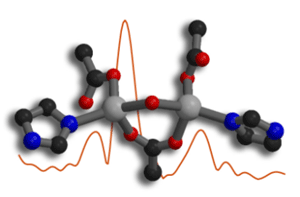
Bacterial infections, such as tuberculosis, have been identified as a world-wide problem leading to the deaths of millions of people each year. The importance of developing new drugs to fight infectious disease caused by these pathogenic organisms is underscored by the emergence of several bacterial strains that are resistant to all currently available antibiotics.1-4 Antibiotics, such as b-lactams, succeed by targeting vital cellular functions either killing the organism or hindering their multiplication. However, through evolution, bacteria will most likely develop resistance to these drugs rendering them useless. Targeting new bacterial-specific pathways is a valid approach to combating this problem.
One of the enzymes in this pathway,8 the dapE-encoded N-succinyl-L,L-diaminopimelic acid desuccinylase (DapE), catalyzes the hydrolysis of N-succinyl-L,L-diaminopimelate to L,Ldiaminopimelate and succinate.9 It has been shown that deletion of the gene encoding DapE is lethal to Helicobacter pylori and Mycobacterium smegmatis.10,11 Therefore, DapEs are essential for cell growth and proliferation making them potential molecular targets for a new class of antibiotics.
In addition, Zn EXAFS data for DapE incubated with two competitive inhibitors, 2- carboxyethylphosphonic acid (CEPA) and 5-mercaptopentanoic acid, establish the binding modes of phosphonate- and thiolate-containing inhibitors. The structural data obtained for CEPA bound to [ZnZn(DapE)] also provides an initial understanding of the transition state for the hydrolysis reaction catalyzed by DapE. Since most pharmaceuticals target the transition state of enzymatic reactions, the structural aspects of [ZnZn(DapE)]-CEPA are particularly important for the rational design of new potent inhibitors of DapE enzymes.
- Prevention, C. f. D. C. a. MMWR Morb. Mortal. Wkly Rep. 1995, 44, 1-13.
- Howe, R. A.; Bowker, K. E.; Walsh, T. R.; Feest, T. G.; MacGowan, A. P. Lancet 1997, 351, 601-602.
- Levy, S. B. Sci. Am. 1998, 278, 46-53.
- Chin, J. New Scientist 1996, 152, 32-35.
- Scapin, G.; Blanchard, J. S. Adv. Enzymol. 1998, 72, 279-325.
- Born, T. L.; Blanchard, J. S. Cur. Opin. Chem. Biol. 1999, 3, 607-613.
- Girodeau, J.-M.; Agouridas, C.; Masson, M.; R., P.; LeGoffic, F. J. Med. Chem. 1986, 29, 1023-1030.
- Velasco, A. M.; Leguina, J. I.; Lazcano, A. J. Mol. Evol. 2002, 55, 445-459.
- Born, T. L.; Zheng, R.; Blanchard, J. S. Biochemistry 1998, 37, 10478-10487.
- Karita, M.; Etterbeek, M. L.; Forsyth, M. H.; Tummuru, M. R.; Blaser, M. J. Infect. Immun. 1997, 65, 4158-4164.
- Pavelka, M. S.; Jacobs, W. R. J. Bacteriol. 1996, 178, 6496-6507.
- Cosper, N. J.; Bienvenue, D. L.; Shokes, J. E.; Gilner, D. M.; Tsukamoto, T; Scott, R. A.; Holz, R. C. J. Am. Chem. Soc. 2003, 125, 14654-14655.
N. J Cosper, D. L Bienvenue, J. E Shokes, D. M Gilner, T. Tsukamoto, R. A Scott and R. C Holz, "The dapE-encoded N-Succinyl-L, L-Diaminopimelic Acid Desuccinylase from Haemophilus influenzae Is a Dinuclear Metallohydrolase", J. Am. Chem. Soc. 125, 14654 (2003)




